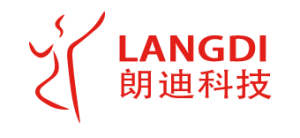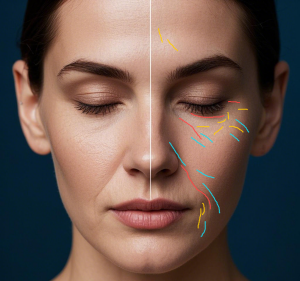Understanding Wrinkles
Facial Wrinkles: Classification, Causes And Coping Strategies
I. Classification
(1) Dynamic wrinkles
- Frontal wrinkles: also known as forehead wrinkles, are horizontally distributed on the forehead. When we raise our eyebrows upwards, when we are surprised, or when we are thinking, the frontalis muscle contracts repeatedly, and folds appear on the forehead skin under the long-term effect. These folds gradually become fixed as we age, forming obvious forehead lines.
- Inter-brow lines: located between the two eyebrows, often in the shape of a “Chuan” or vertical. Frequent contraction of the frowning and descending muscles is the main reason for their formation. When we express our emotions, such as frowning, anger, or anxiety, these muscles move involuntarily, which over time creates inter-brow lines.
- Crow’s feet appear: on the outer side of the tail of the eye and are radial in shape. Frequent contraction of the orbicularis oculi muscle is the key to crow’s feet. Everyday actions such as smiling, laughing, and blinking will involve the orbicularis oculi muscle, and over time, crow’s feet will appear at the end of the eye.
- Nasolabial furrow lines: extend from both sides of the nose to the corners of the mouth, although more obvious when the expression is rich, the cause is more complex. In addition to the pulling effect of facial expression muscles (e.g., zygomaticus major muscle, etc.), it is also related to the downward movement of facial fat pads, skin laxity, and other factors.
(2) Static wrinkles
- Fine lines around the eyes: In addition to crow’s feet, there are also some fine static wrinkles around the eyes, commonly found on the lower eyelid and upper eyelid. The skin around the eyes is thin and tender, with less distribution of sebaceous glands and sweat glands and easy loss of water. Coupled with long-term ultraviolet damage, a dry environment, and frequent activities of eye muscles, the collagen and elastic fibers of the skin around the eyes are damaged, resulting in fine lines.
- Perioral wrinkles: Fine wrinkles surrounding the mouth, mostly perpendicular to the lips, also known as lip lines. The movement of the orbicularis oris muscle, long-term lip expressions (such as pursing and pouting), as well as skin dryness and collagen loss all contribute to the formation of perioral wrinkles. As we age, the skin’s support structure around the mouth weakens, and wrinkles become more pronounced.
- Neck wrinkles: The skin on the neck is thin and is subject to frequent daily activities, such as turning the head and lowering the head. As age increases, collagen and elastic fibers in the skin decrease, and the neck skin gradually relaxes. This, coupled with bad habits such as looking down at cell phones and computers for a long time, accelerates the production of neck wrinkles, and these wrinkles are usually distributed horizontally or vertically.
Ⅱ. Causes
(1) Internal factors
- Natural aging: This is the main internal cause of facial wrinkles. With age, the metabolism of the skin slows down, and the epidermal cell renewal cycle is prolonged, from about 28 days when young to 40 – 50 days or even longer. At the same time, the synthesis of collagen and elastin fibers in the dermis decreases, decomposition increases, and the content gradually decreases, resulting in thinning of the skin, loss of elasticity, and inability to support the skin’s firmness, thus forming wrinkles.
- Genetic factors: Genetics largely determines the innate qualities of the skin, including skin thickness, elasticity, and the structure of collagen and elastic fibers.
(2) External factors
- Ultraviolet radiation: Ultraviolet radiation is an important external factor leading to skin aging, of which UVA and UVB cause significant damage to the skin. UVA can penetrate the surface layer of the skin to the dermis, destroying collagen and elastin fibers, while UVB mainly damages the epidermis, triggering skin inflammation and interfering with the normal metabolism of the skin cells, accelerating the aging of the skin.
- Frequent facial expression: Frequent facial expressions will make the facial muscles contract repeatedly, producing continuous pulling on the skin. For example, long-term frowning will make the skin between the eyebrows repeatedly fold, and laughing will make the tail of the eyes and the corners of the mouth skin pulled, over time, these parts of the skin in the muscle attachment point of the formation of folds, and gradually develop into permanent wrinkles.
- Lifestyle habits: Bad lifestyle habits have a great impact on skin health. Staying up late for a long time will disrupt the body’s biological clock, affecting the endocrine system so that the skin’s metabolism and self-repair function are impaired.
- Environmental factors: prolonged exposure to a dry environment will result in rapid loss of skin moisture, leading to dry, dehydrated skin and reduced elasticity, which in turn is prone to wrinkles. In addition, environmental pollution, such as airborne dust, particulate matter, chemical pollutants, etc., will adhere to the surface of the skin, clogging pores, affecting the skin’s respiration and metabolism, and accelerating skin aging.
Ⅲ. Coping Strategies
(1) Daily care
- Cleansing: It is vital to choose gentle, suitable cleansing products for your skin type.
- Moisturizing: Choose the right moisturizing products according to your skin type. Dry skin is suitable for heavy moisturizing creams, and oily skin is suitable for refreshing lotions. Neck skin also needs special care, can use special neck cream.
- Sun protection: Sun protection is a key measure to prevent facial wrinkles. Every day 15 – 30 minutes before going out, you should evenly apply sunscreen, pay attention to apply comprehensively, including the face, neck, ears and other parts.
(2) Adjustment of living habits
- Regular work and rest: Ensure adequate sleep, 7 – 8 hours of quality sleep every night will help the repair of various organs of the body and the metabolism of the skin.
- Eat right: Diet has a significant impact on skin health. Consume foods rich in vitamin C, vitamin E, carotene and other antioxidants, which can remove free radicals from the body and reduce oxidative damage. At the same time, ensure adequate protein intake, protein is an important raw material for skin repair and regeneration, which helps to maintain the elasticity and firmness of the skin.
- Moderate exercise: at least 150 minutes of moderate-intensity aerobic exercise per week, exercise can promote blood circulation, enhance the body’s metabolic function, so that the skin gets more oxygen and nutrients, and at the same time help to regulate the endocrine system, to maintain the health of the skin.
(3) Medical cosmetic means
- Botulinum toxin injection: Botulinum toxin reduces dynamic wrinkles by blocking the nerve impulses between nerves and muscles and relaxing the over-contracted muscles.
- Hyaluronic acid injection: Hyaluronic acid has strong moisturizing and filling function, injecting it into the dermal layer of the skin can fill in the sunken wrinkles, increase the moisture content of the skin, and restore the skin to fullness and smoothness.
- Laser cosmetic treatment: Laser treatment utilizes the thermal effect of laser to stimulate collagen proliferation in the skin, promoting the renewal and reorganization of skin cells.
- Radiofrequency Cosmetology: Radiofrequency technology emits high-frequency electromagnetic waves, causing collagen in the deeper layers of the skin to contract with heat and stimulate the generation of new collagen, thus achieving the goal of tightening the skin and reducing wrinkles.
- Surgical treatment: For severe facial wrinkles, surgical methods are an effective option. Although the effect of surgery is long-lasting, the risk of surgery is relatively high and the recovery time is long, so you need to choose carefully.
Facial wrinkles are the result of a combination of factors. To deal with facial wrinkles, it is necessary to make comprehensive use of daily care, adjustment of lifestyle habits and medical cosmetic means.
At the same time, each person’s skin condition and wrinkle type is different, you can use the Langdai Facial Analyzer to determine the type of wrinkles, choose the appropriate coping strategies, and adhere to the long-term, in order to effectively delay the generation of facial wrinkles, and to maintain the health and youthfulness of the skin.










